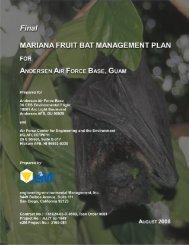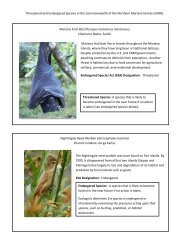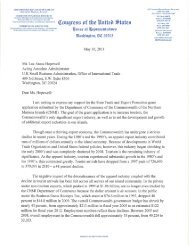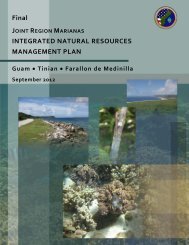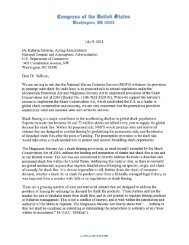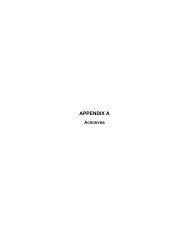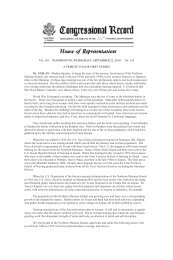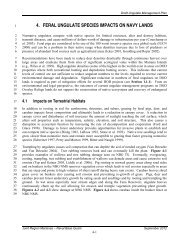Draft Ungulate Management Plan1234567891011121314151617Figure 3-5. Hunter Effort (8-hour Days) Per Pig Taken at NBG TS (Totals for Fiscal Year)3.2 Philippine DeerThe nonnative Philippine deer was introduced to Guam from the Philippines. These animals werebrought to Guam during the term of Mariano Tobías, who served as the island’s Spanish governorbetween 1771 and 1774. The exact date of introduction is unknown, but it is likely that Tobías importedthe deer as a new meat source for the Chamorro people in 1771 (Wiles et al. 1999). The species wasoriginally described as Cervus unicolor and commonly referred to as Sambar deer (Wheeler 1979). Thelargest populations of Philippine deer in its native range are located on Luzon, Mindanao, Samar, andLeyte islands (IUCN/SSC Deer Specialist Group 1998, Wiles et al. 1999).3.2.1 DescriptionThe Philippine deer is a short, stocky forest-dwelling deer. Males are much larger than females. Geneticstudies by Meijaard and Groves (2004) found that the Philippine deer was morphologically similar toPhilippine spotted deer (C. alfredi). The mean length of a male is 55 inches and mean weight is 141pounds; however, males can reach over 210 pounds (Wiles et al. 1999). Females have a mean length of49.7 inches and mean weight of 89 pounds (Wiles et al. 1999). Mean weights and measurements of adultdeer on Guam are listed in Table 3-3.18Joint Region Marianas – Naval Base Guam September 20123-10
Draft Ungulate Management Plan12Table 3-3. Mean and Standard Deviation of Various Measuresof Adult Philippine Deer (Cervus mariannus) from GuamSexTotal weight(pounds)Total length(feet)Tail length(inches)Shoulderheight (feet)Hind footlength (inches)Ear(inches)MaleFemale141.1 ± 45.2(21)89.1 ± 17.9(21)4.6 ± 0.5(24)4.1± 2.6(24)Source: Wiles et al. (1999)Note: Number of animals sampled is provided in parentheses.4.5 ± 0.6(24)4.2 ±0.6(24)2.6 ± 0.3(25)2.3 ± 0.13(25)13.4 ± 1.0(23)11.4 ± 1.1(23)4.2 ± 0.2(25)4.0 ± 0.2(25)345678910111213141516171819202122232425262728293031The antlers of mature bucks are slender and generally three-tined; however antlers with four or five tineshave been reported (Wheeler 1979). The single, long brow tine is the first division of the antlers thatbranches from the main base and the upper tine features a rear-facing terminal fork. The total antlerlength of a three-tined deer ranges from 2.2 to 5.3 feet (Wheeler 1979, Wiles et al. 1999). Antlermorphology differs slightly between deer populations in Micronesia, suggesting some genetic variation.For example, the enlarged antlers found on Rota, Pohnpei, and Saipan have not been reported on Guam.However, genetic studies among the islands have not been conducted (Wiles et al. 1999). The antlers areshed and new antlers grow yearly. This replacement period varies from 16 to 19 weeks depending on theage of the deer and the number of antler tines. Philippine deer can shed their antlers at any time of theyear (Wheeler 1979).3.2.2 BehaviorPhilippine deer are known to be secretive but produce a range of barks, bleats, and wails that vary withage and sex (Wheeler 1979). Social organization is generally limited to small family groups of mixedage, but some adult-only groups have been documented (Wiles et al. 1999). No comprehensiveinvestigation of movements and specific habitat use has been conducted on Guam. However, movementpatterns and home-range size of tropical ungulate species are typically determined by seasonal changes inthe environment (McShea et al. 2001). Habitat selection is strongly influenced by energy and nutrientneeds particularly during gestation and lactation (Aung et al. 2001, McShea et al. 2001).The Philippine deer forages nocturnally, consuming fruits, shoots, leaves, stems, and bark ofapproximately 65 different plant species on Guam (Wiles et al. 1999). Their diet includes a variety ofwoody and herbaceous plants and grasses (Wheeler 1979), with a preference for native woody speciesover nonnative species (Department of the Navy 2006). In areas where the deer are present, a noticeablebrowse line 2 is evident, and forest regeneration is prevented through browsing of seedlings and saplings.The Philippine deer is known to consume the following on Guam: the fruit and seeds of dugdug(Artocarpus mariannensis); the frond stems, fruit, and bark of queen sago (Cycas circinalis); the foliageand fruit of lemondichina, corkystem passionfruit (Passiflora suberosa), thatch screwpine; the foliage ofChinese banyan (Ficus microcarpa), Pacific banyan, Psychotria mariana, Scaevola sericea, Scleria sp.,fire tree, and mission grass; and the bark of Pipturus argenteus, Ahgao, and vitex (Wiles et al. 1999). Inaddition, Wheeler (1979) reports that Premna integrifolia, mimosa (Leucaena glauca), coconut palm,2 A browse line is defined as the boundary between upper normal plant growth and lower stripped and eaten-backgrowth that indicates the height reached in feeding by large herbivores.Joint Region Marianas – Naval Base Guam September 20123-11



